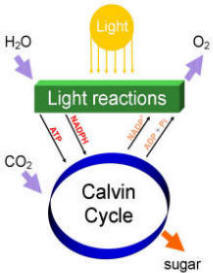Nutrition
It has to stay alive somehow
The Sweet Violet is an autotroph, which means it can produce it's own food. The Sweet Violet obtains water and food through two different processes. The water from the ground is transported to the plant through specialized structures called xylem cells. The xylem cells transport the water from the roots up to the leaves where photosynthesis and evaporation take place. On the leaves of the Sweet Violet there are pore openings called stomata. The stomata's ability to open and close allows for gas exchange and water loss. The water is pulled up through the xylem cells, no
 t
pushed up.
t
pushed up.
Water moving up the xylem is a result of transpiration, adhesion, cohesion
and tension.
First, transpiration is the process of water leaving the stomata and
entering the atmosphere. Next, adhesion is the ability of water molecules
to have high affinity for other polar molecules; for instance water being
attracted to the xylem cell walls. Third, cohesion is the ability of water
molecules to have a high tendency to stick to one another. Adhesion and
cohesion create tension. The tension created helps with the capillary action
that pulls the water up to the leaves of the plant.
After water is moved to the top of the plant it goes to the phloem to transport the nutrients made from photosynthesis to the rest of the plant. The nutrients needed for the plant to grow are obtained by photosynthesis. Photosynthesis is a process in which the plant uses the sunlight to make carbohydrates. This process has two steps. The first step is the light dependent reaction which occurs in the thylakoid membrane in the chloroplast. The light dependent reactions produce ATP, NADPH and O2. This step creates energy carriers that can be used in the second step. The second step of photosynthesis, which takes place in the stroma of the chloroplasts, is the light independent step which includes the Calvin cycle. This step produces glucose, ADP and NADP+. The plant can use the glucose produced in the second step for energy. The diagram to the right can help you understand this process.
